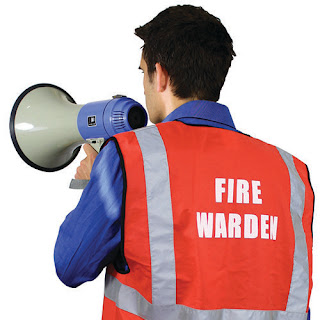Fire wardens are appointed for offices, schools, care homes, healthcare premises and other public places. They are the people who are responsible for ensuring that all the fire safety procedures are followed and are responsible for the protection of staff, clients and visitors in the case of a fire.
Role of a fire warden
 |
| Fire Warden Role |
- The fire warden is responsible for making sure the right evacuation procedures are followed
- Checking the building for any customers or workers who ignore the alarm and subsequently reporting to the fireplace marshal
- Ability to use fire fighting equipment
- Shutting down vital and dangerous equipment
- Liaising with the fire rescue team on arrival
- By the time the fire brigade arrives they are responsible for understanding that everybody is accounted for and is at a safe distance from the fire
How many fire wardens are required?
- The number of Fire Wardens required depends upon the structure and complexity of the workplaces
- For large organisations and businesses, multiple fire wardens are required, different wardens assigned to specific departments and smaller areas of responsibility because one fire warden can’t deal with alone
- It is advisable to train an extra warden to cover sickness and other absences
What is Fire warden training?
 |
| Fire Warden Training (Source - Magie Plus Plus) |
- A fire warden takes on responsibility in the event of a fire
- Fire warden training is necessary for the warden to understand the role
- They first learn about “awareness of human behaviour in fires”
- The training teaches about fires and the safety measures to be taken immediately in the event of a fire, how fire spreads as well as the mechanism and usage of fire extinguishers
- Regular fire alarm checks and fire practice may also be the duties of Fire warden
How often Fire warden training should happen?
The frequency of training for fire wardens depend upon the level of risk at the premises, number of people in the premises and the nature of the business.
The fire warden training is normally held between 1-3 years and should be recorded in company fire safety procedures.
What will Veteran fire safety services provide you?
We provide an extensive experience of delivering a range of fire consulting services and fire risk assessments across a variety of sectors and buildings.
We train fire wardens and provide professional training. Call us on 01530 588 189 to talk with our expert or visit our website http://www.veteranfiresafety.co.uk/training/fire-safety-training/fire-warden-training for more details.





